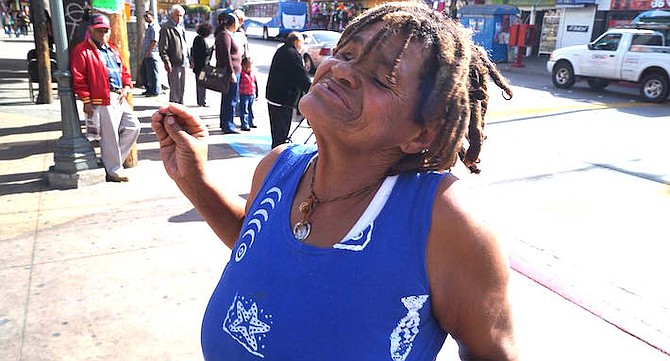 Facebook
Facebook
 X
X
 Instagram
Instagram
 TikTok
TikTok
 Youtube
Youtube

Homeless Tijuana icon, Maria Luisa Castro, also known as “La Maguana,” passed away on March 21 at the age of 61. Ladened with mental diseases and infections like HIV and schizophrenia, Maria Luisa died in El Refugio, an asylum in Flores Magón neighborhood, far from her usual stomping grounds. Her body was transferred to the city morgue.
Maria Luisa was well known by Tijuanenses for her extravagant dancing, often public nudity and drunken behavior, as well as the many legends that surrounded her existence. She often slept outside the supermarket Calimax on the corner of Calle Segunda and Avenida Constitución. A utility box near her sleeping cot held shampoo and soap, one of Maria Luisa’s favorite things. On sunny warm days, she showered on the street with two buckets, one filled with soapy water, the other with water to rinse off.
La Maguana was mentioned in songs by local bands. El Teacher del Rock and Revolucion Norteña wrote full songs about her. Nanobrewery Cervecería Zona Norte has a beer named La Mahuana (alternative spelling), a Mexican stout for the queen of the zone. Maria Luisa has been on shirts, stickers, posters, and even a bar bears her name.
Despite all this, Maria Luisa did not like the name Maguana and did not understand why people tell her she was famous.
Maria Luisa was often the subject for newscasters and reporters. She was also a subject of fake news as a year ago, the rumor of her death by a faux news website went viral in the city. Four years ago, when I searched for her to write my own story, I saw her acting erratic outside a convenience store. I decided not to bother her.
Two nights after the story was published, I bumped into Maria Luisa outside what used to be my favorite dive bar (La Nueva Pachanga). She was right outside the heavy blue curtains as I exited the bar. Her bad eye was fixated on me as if she knew something. It sent shivers down my spine. From that moment, I vowed to repay the money I earned from writing the article.
For the following years, I gave Maria Luisa a dollar or pesos whenever I saw her, which was around once a week. For the most part, she was outside Cathedral of Our Lady Guadalupe, Tijuana’s oldest cathedral. You would find her selling gum or arbitrary candy, or simply sitting down eating spaghetti (her favorite food) and drinking soda. Every once in a while I would see her drunk and belligerent holding a plastic bottle of Tonayan, one Mexico’s cheapest liquors.
I never repaid my full debt and I still owed her $58.


Homeless Tijuana icon, Maria Luisa Castro, also known as “La Maguana,” passed away on March 21 at the age of 61. Ladened with mental diseases and infections like HIV and schizophrenia, Maria Luisa died in El Refugio, an asylum in Flores Magón neighborhood, far from her usual stomping grounds. Her body was transferred to the city morgue.
Maria Luisa was well known by Tijuanenses for her extravagant dancing, often public nudity and drunken behavior, as well as the many legends that surrounded her existence. She often slept outside the supermarket Calimax on the corner of Calle Segunda and Avenida Constitución. A utility box near her sleeping cot held shampoo and soap, one of Maria Luisa’s favorite things. On sunny warm days, she showered on the street with two buckets, one filled with soapy water, the other with water to rinse off.
La Maguana was mentioned in songs by local bands. El Teacher del Rock and Revolucion Norteña wrote full songs about her. Nanobrewery Cervecería Zona Norte has a beer named La Mahuana (alternative spelling), a Mexican stout for the queen of the zone. Maria Luisa has been on shirts, stickers, posters, and even a bar bears her name.
Despite all this, Maria Luisa did not like the name Maguana and did not understand why people tell her she was famous.
Maria Luisa was often the subject for newscasters and reporters. She was also a subject of fake news as a year ago, the rumor of her death by a faux news website went viral in the city. Four years ago, when I searched for her to write my own story, I saw her acting erratic outside a convenience store. I decided not to bother her.
Two nights after the story was published, I bumped into Maria Luisa outside what used to be my favorite dive bar (La Nueva Pachanga). She was right outside the heavy blue curtains as I exited the bar. Her bad eye was fixated on me as if she knew something. It sent shivers down my spine. From that moment, I vowed to repay the money I earned from writing the article.
For the following years, I gave Maria Luisa a dollar or pesos whenever I saw her, which was around once a week. For the most part, she was outside Cathedral of Our Lady Guadalupe, Tijuana’s oldest cathedral. You would find her selling gum or arbitrary candy, or simply sitting down eating spaghetti (her favorite food) and drinking soda. Every once in a while I would see her drunk and belligerent holding a plastic bottle of Tonayan, one Mexico’s cheapest liquors.
I never repaid my full debt and I still owed her $58.
Comments